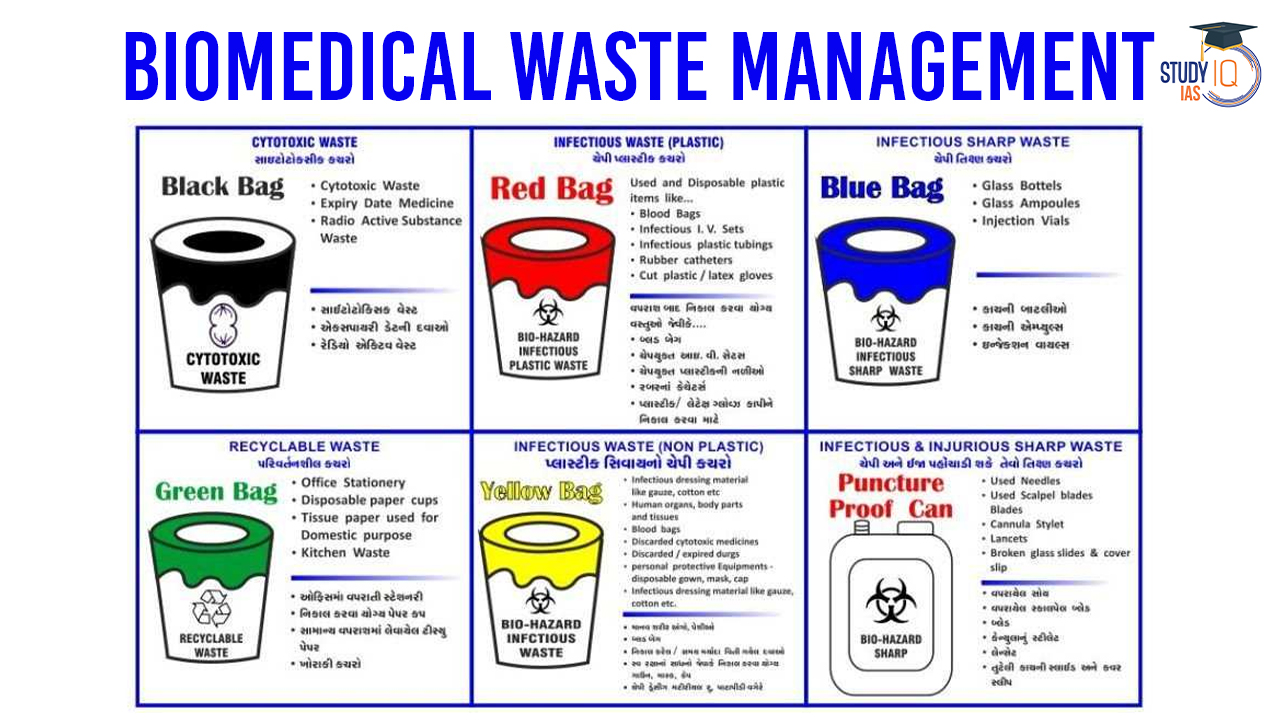Table of Contents
Biomedical waste management refers to the proper handling, collection, transportation, treatment, and disposal of waste generated during healthcare activities. This type of waste, also known as medical waste or healthcare waste, poses potential hazards to human health and the environment due to its infectious, toxic, and hazardous nature. Effective biomedical waste management is crucial to prevent the spread of infections and protect public health.
What is Biomedical Waste?
Biomedical waste encompasses materials with infectious potential produced during the medical care, diagnosis, and vaccination of humans and animals, existing in solid or liquid states. Examples involve:
- Sharps like needles, syringes, scalpels, and broken glass.
- Human tissues or identifiable body parts, often result from amputations.
- Veterinary hospital waste, including animal tissues.
- Used medical supplies such as bandages, dressings, and gloves.
- Liquid waste from infected regions.
- Laboratory discards.
Distinguished from regular refuse, biomedical waste demands specific disposal and treatment procedures to mitigate health and environmental risks.
Biomedical Waste Management 2024
The International Conference on Biomedical Waste Management, Recycling, and Disposal will be held in Brno, Czech Republic on May 29, 2024. This event will bring together leading experts, academicians, speakers, industry professionals, and scientists.
Biomedical waste (BMW) is any waste that contains infectious or potentially infectious materials. It can be in both solid and liquid forms and is generated during the diagnosis, treatment, and immunization of humans and animals. BMW may also include waste associated with the generation of biomedical waste that visually appears to be medical.
Biomedical Waste in India
The surge in COVID-19 cases has led to an overwhelming increase in biomedical waste. In response, the Central Pollution Control Board (CPCB) has released directives regarding the proper disposal of biomedical waste. According to these guidelines, biomedical wastes are gathered in yellow bags and subsequently transported to either a Common Biomedical Waste Treatment Facility (CBWTF) or a waste-to-energy plant. At these facilities, the waste undergoes processes such as incineration, autoclaving, or burning to generate energy.
Presently, there are approximately 200 authorized facilities for the common treatment and disposal of biomedical waste across 28 states in India. These facilities play a crucial role in ensuring the safe and environmentally sound management of biomedical waste.
Types of Biomedical Waste
Biomedical waste is classified into several types based on its nature, potential hazards, and source. The common types of biomedical waste include:
- Infectious Waste: Cultures, stocks, and specimens of infectious agents, waste from surgery or autopsy that contains blood or other potentially infectious materials.
- Hazardous Waste: Chemicals, pharmaceuticals, or materials contaminated with hazardous substances.
- Radioactive Waste: Materials used in nuclear medicine, radioactive isotopes used in research or medical procedures.
- Sharps: Needles, syringes, scalpels, and other objects capable of causing punctures or cuts.
- Pathological Waste: Human tissues or identifiable body parts resulting from surgery, amputation, or autopsy.
- Pharmaceutical Waste: Expired or unused medications, vaccines, and other pharmaceutical products.
- Genotoxic Waste: Waste containing genotoxic substances that can cause genetic mutations or other adverse health effects.
- Chemical Waste: Waste generated from laboratory processes, chemical analysis, or cleaning activities in healthcare facilities.
- Cytotoxic Waste: Waste containing cytotoxic drugs used in cancer treatment.
- General Healthcare Waste: Non-hazardous and non-infectious waste generated in healthcare settings, such as packaging materials, paper, and plastic.
We’re now on WhatsApp. Click to Join
Category of Biomedical Waste
The Biomedical Waste Management Rules of 2016 classify healthcare facility-generated biomedical waste into four categories, each identified by a specific colour code and segregation pathway. The types of biomedical waste assigned to each category are outlined as follows:
- Yellow Category: Involves waste from microbiological and biotechnological laboratories, anatomical waste, and discarded medicines.
- Red Category: Encompasses infectious waste like blood-soaked items, human anatomical waste, and sharps like needles and syringes.
- White Category: Includes waste generated from solid waste like tubing and catheters, as well as items contaminated with blood and body fluids.
- Blue Category: Pertains to waste generated from items like glassware, plastics, and metallic implants.
These colour-coded categories facilitate proper segregation and disposal of various types of biomedical waste, ensuring effective and safe waste management practices in healthcare settings.
Effects of Biomedical Waste
- Infections Spread: Biomedical waste harbours pathogens, risking the spread of infections.
- Environmental Pollution: Poor disposal contaminates soil, water, and air, posing long-term ecological risks.
- Health Risks for Handlers: Workers face dangers from exposure to infectious materials, chemicals, and sharps.
- Community Impact: Nearby residents may suffer health issues due to contaminated water or air.
- Antibiotic Resistance: Incorrect drug disposal contributes to antibiotic resistance, a threat to public health.
- Injuries and Accidents: Improper handling of sharps can cause injuries and infection transmission.
- Legal Consequences: Non-compliance with waste management rules results in fines and legal actions.
- Wildlife and Ecosystems: Contaminated waste harms wildlife, disrupting ecosystems and biodiversity.
- Aesthetic Impact: Unmanaged waste affects the environment’s visual appeal, posing aesthetic concerns.
- Long-term Damage: Persistent pollutants in biomedical waste cause enduring environmental harm.
Biomedical Waste Management
Central Level Oversight
The Central Pollution Control Board (CPCB) rigorously enforces biomedical waste management rules for scientific disposal at the national level.
State Level Oversight
Chief Secretaries of States/U.Ts supervise compliance, ensuring every healthcare facility within their jurisdiction obtains authorization and adheres to norms.
District Level Oversight
District Magistrates implement District Environmental Plans, contributing to effective biomedical waste management.
Management Steps
- Waste Segregation: Utilize color-coded and barcode-labeled bags/containers at the source for efficient waste segregation.
- Pre-treatment: Conduct pre-treatment of laboratory and highly infectious waste, adhering to guidelines.
- Intra-mural Transportation: Transport segregated waste to the central storage area within the healthcare facility.
- Temporary Storage: Temporarily store biomedical waste in the central storage area.
- Treatment and Disposal: Utilize Common Biomedical Waste Treatment Facility (CBWTF) or Captive facility for proper treatment and disposal.
Responsibilities
- The initial five steps (Segregation, Collection, Pre-treatment, Intramural Transportation, and Storage) fall under the Health Care Facility’s (HCF) exclusive responsibility.
- Treatment and Disposal primarily rest with the CBWTF operator, except for lab and highly infectious waste, pre-treated by the HCF.
Pre-treatment Procedures
Pre-treatment involves disinfection or sterilization on-site for laboratory waste, microbiological waste, blood samples, and blood bags, following WHO or NACO guidelines.
Occupational Safety Responsibility
The healthcare facility in charge ensures the occupational safety of workers handling biomedical waste, emphasizing staff well-being.
Biomedical Waste Management Challenges
- Limited Health Hazard Awareness: Inadequate understanding of health risks associated with healthcare waste persists.
- Insufficient Training: Lack of proper training contributes to shortcomings in effective waste management practices.
- Absent Management Systems: The absence of comprehensive waste management and disposal systems exacerbates the issue.
- Resource Constraints: Inadequate financial and human resources hinder efficient waste management efforts.
- Low Priority: The topic receives insufficient attention and priority in various settings.
- Regulatory Gaps and Enforcement Issues: Many countries lack appropriate waste management regulations, and even when in place, enforcement is often lacking.
Biomedical Waste Management UPSC
Biomedical waste (BMW) encompasses waste generated from human and animal medical activities, research, and health camp productions. It includes anatomical waste, treatment tools like needles, and various materials from healthcare facilities. The World Health Organization categorizes BMW into eight types. Treatment methods involve incineration, chemical disinfection, wet thermal treatment, microwave irradiation, land disposal, and inertization. Efficient Biomedical waste management comprises collection, segregation, transportation, treatment, and disposal. Color-coded bins, technologies like incineration, autoclaving, and environmental considerations are vital aspects in BMW management.


 Marlin Fish: Species, Features, Appearan...
Marlin Fish: Species, Features, Appearan...
 Great Hornbill (Buceros bicornis): Habit...
Great Hornbill (Buceros bicornis): Habit...
 Climate Change Impact On India’s Coast...
Climate Change Impact On India’s Coast...





















